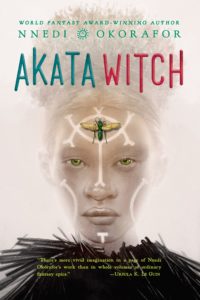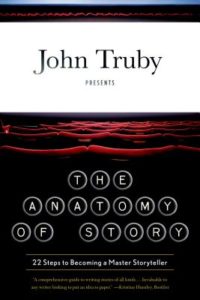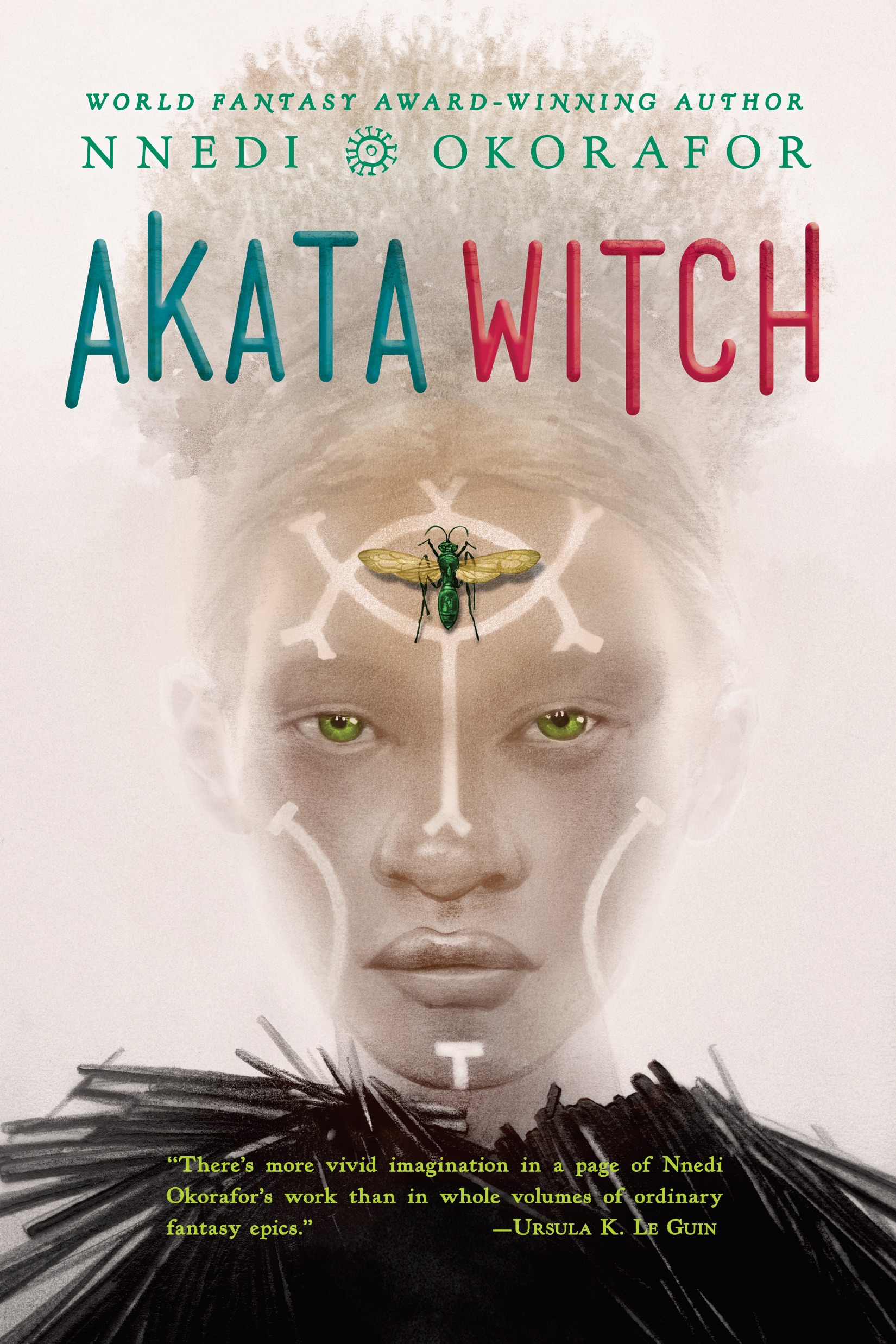craft review by Jen Jobart
 Akata Witch by Nnedi Okorafor is the story of a girl who must embrace her otherness in order to save the world.
Akata Witch by Nnedi Okorafor is the story of a girl who must embrace her otherness in order to save the world.
Sunny, who recently moved from the US to Nigeria, is struggling to fit in. Her albino skin makes her “other” in her new community. Then she makes a discovery that makes her even more of an outcast – she has magical powers. Little by little, she makes friends who also have magic and who help her find the best within herself. She and her new friends must pool their talents to stop Black Hat Otokoto from ending the world.
In chapter 5 of his book The Anatomy of Story, John Truby talks about how to scaffold a story with plot structure and characters that all support a moral argument. Akata Witch is a rich case study for seeing how this works in practice.
Both books are excellent and worth reading in their own right. This post definitely contains spoilers, so if you haven’t yet read both books, continue reading at your own risk.
Structuring a Moral Argument
In The Anatomy of Story, Truby presents a plot structure that exists to prove the moral argument. This plot structure parallels the hero’s journey, but differs in important ways. My own interpretation of the difference between the two is that the hero’s journey is what happens, whereas the moral argument plot structure is about the significance of what happens. This is the “why do we care?” point that editors sometimes make.
In Akata Witch the significance centers on Sunny’s identity. Early in the novel, we see Sunny struggling against her otherness. Through the course of the story, she learns that her otherness is valuable and must be embraced and not rejected. She wants to fit in, but in order to fulfill her destiny, she needs to be herself.
According to Truby, the thread of a moral argument plot structure is found in the immoral actions that the main character takes, and how she recovers from them. In other words, it shows how the character learns from her mistakes.
At the beginning of Akata Witch, Sunny wishes she could be like everyone else. Her first immoral action is rejecting Orlu because she is being defensive, when he was only trying to defend her. Her second immoral action is showing her spirit face when she gets in another fight. Sunny’s “aha” moment happens during her final action against her opponent. In the climactic scene, Sunny must have confidence in herself and her own abilities in order to send Ekwensu back into the dark, a confidence she has learned from both her overconfidence and her lack of confidence.
Characters as Variations on a Theme
Before I read Truby’s chapter on moral argument, I assumed that the theme of a book was mostly evident in the main  character’s inner journey. That may be true, on the surface. But Truby points out that having an entire cast of characters who all exist to support a moral argument makes a story multi-faceted and much richer.
character’s inner journey. That may be true, on the surface. But Truby points out that having an entire cast of characters who all exist to support a moral argument makes a story multi-faceted and much richer.
The central characters in Akata Witch all exist to support the idea that one must embrace one’s entire self to find one’s power. They are all, to some extent, outcasts. How they fare depends largely on whether they accept and embrace their own strengths and weaknesses, or whether they reject themselves and turn to others for their power.
SUNNY, the main character, has one foot in Nigeria and one in America, and is an albino in a black community. Even in the spirit world, she is a free agent, an anomaly in a society of anomalies.
At the beginning of the story, she is ostracized for her skin color and otherness and attacks those who point it out. To find her strengths and overcome the villain, Black Hat Otokoto, Sunny must embrace her entire self, even the parts that are hardest for herself and others to accept. By the end of the story, she has she learned that those qualities are exactly what are needed to save the world. She has embraced her otherness and celebrates its power.
Sunny’s friend ORLU accepts Sunny for who she is and defends her against others. Orlu is ashamed of his dyslexia but his parents knew that “to have such a serious ‘disability’ meant his talent would be amazing. And it is. Orlu can undo things. Throw a juju at him and he can undo it and make it harmless or useless without ever knowing what he’s doing…. Once [Anatov] started teaching Orlu how to hone this skill, his ability to read kicked in.”
Orlu’s neighbor CHICHI embraces her otherness from the start and rejects people who strive to be the same as others. She looks for otherness in her friends (especially Sunny) and views it as a strength.
The fourth of their group, SASHA, is arrogant about his differences and must learn to follow the rules in order to be his best self.
In Chapter 6, Okorafor describes Chichi and Sasha: “Most people would dismiss Chichi and Sasha as disrespectful, uncouth children who can’t even get through a year of school. They’d insist they were destined to be criminals and streetwalkers. Doctors would prescribe Ritalin for their ADD and then throw their hands up, perplexed, when it didn’t work. But as Leopard children, they’re destined for great, great things. These two could probably pass their second and third levels if they were emotionally mature. Which they are not. Not even close.”
The antagonist, BLACK HAT OTOKOTO, hungers for power. However, his gifts aren’t sufficient to bring the Ekwensu through to the world. He kills children so that he can use their gifts to help him. He rejects his own potential and relies on children and Ekwensu to make him powerful.
All of these characters bring insight to the theme of embracing one’s otherness. The book is truly Sunny’s story, but all the other characters enrich her story by the ways they engage with the theme. Together, they create Truby’s moral argument.
A personal note
Akata Witch really struck a nerve for me. One of my children has really struggled to fit into classrooms. He is incredibly smart and gifted, but has trouble sitting still and following instructions. Traditional education standards just aren’t working for him. This year, I’ve finally decided to stop trying to fit a square peg into a round hole and homeschool him. I read Akata Witch as I was making that decision, and it was almost a spiritual message for me. The quote from chapter 6 above really resonated with me. My kid is a Sasha. My kid is a Chichi. My job, as his mom, is to support him in growing his emotional maturity so that he can bring his unique gifts to the world.
Sometimes the books we need to read find us. This was true for me, in this case.
At least part of how Okorafor crafted her powerful message was through the focused moral argument–not just one character’s journey, but how each character’s experience spoke to a theme. Her book was one of many pieces in my own life that drew me toward change I needed to make.
The power of story is deep, and by intentionally crafting stories where all the pieces work together as a whole, we as writers have the power to touch readers’ lives, as Okorafor’s book touched me.
Jen Jobart writes middle grade fiction and is always sending characters she loves on dangerous adventures. She is an active member of the SCBWI and has studied writing for children through Stanford’s Continuing Studies program. When Jen’s not writing, she’s outside gardening and raising chickens at her home in the San Francisco Bay Area. Find her at www.jenjobart.com.


I love this review. Thank you for posting this!
In Akata Witch Sunny moves from the U.S. to Nigeria–rather than the other way around.
The story takes place in Nigeria, but Sunny’s background (living in the U.S. for some of her formative years) give her a unique outlook that those who’ve lived in Nigeria for their whole lives do not have.
Thanks, Jodie! We’ll make the correction. Apologies for the error.
[…] It happened on Saturday, I had to go with my mum to the famous Oyingbo market. It was part of my duty as a “good daughter”. Nnedi Okorafor’s books has one very dominant feature, Juju and magic. And her famous protagonist Sunny Nwazue had strong allergies towards Juju, even after she became a Leopard Person (Yeap, the technical part of the narrative. Get Nnedi Okorafor’s Akata Witch to figure this out or read the summary here) […]